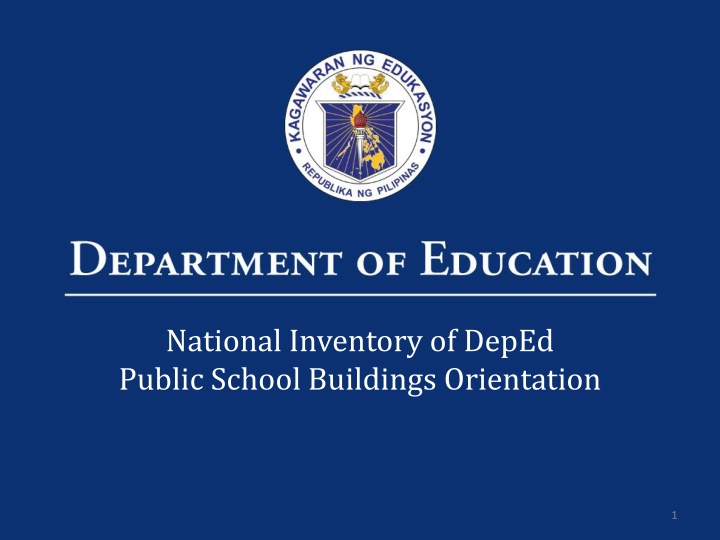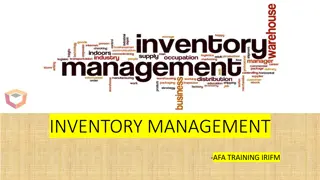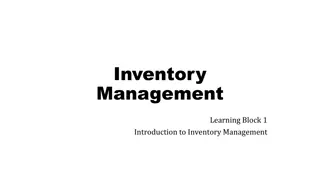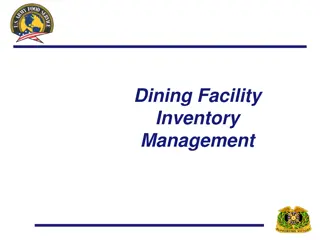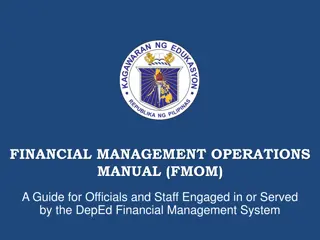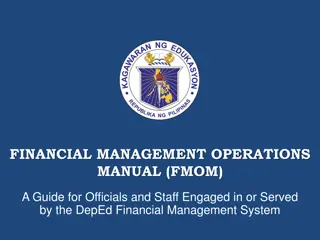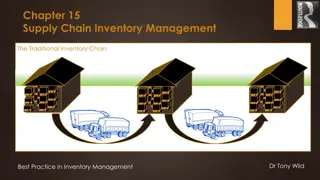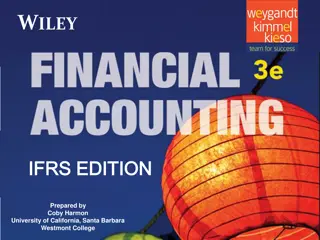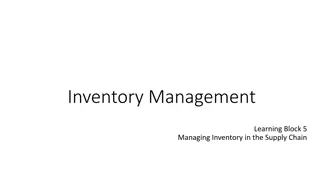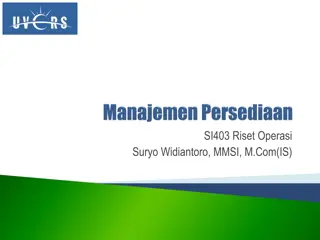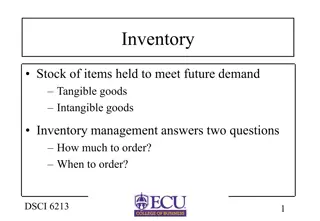Enhancing Inventory Management for DepEd Public School Buildings
Establishing an accurate inventory of school buildings in DepEd public schools is crucial for planning and decision-making processes. This initiative aims to provide child-friendly and conducive learning environments by assessing current inventories, identifying needs, and allocating resources accordingly. The process involves school guidelines, officials in charge, and site development plans to ensure effective management. Annual updates are planned to maintain comprehensive baseline data for future planning.
Download Presentation

Please find below an Image/Link to download the presentation.
The content on the website is provided AS IS for your information and personal use only. It may not be sold, licensed, or shared on other websites without obtaining consent from the author.If you encounter any issues during the download, it is possible that the publisher has removed the file from their server.
You are allowed to download the files provided on this website for personal or commercial use, subject to the condition that they are used lawfully. All files are the property of their respective owners.
The content on the website is provided AS IS for your information and personal use only. It may not be sold, licensed, or shared on other websites without obtaining consent from the author.
E N D
Presentation Transcript
National Inventory of DepEd Public School Buildings Orientation 1
Rationale DepEd continues to work towards making all schools child-friendly, safe and conducive to learning. Getting the accurate inventory is essential in this process. Schools submit enrolment and inventory data in the EBEIS. Part of this effort is providing the appropriate facilities for each school based on data collected from our schools and standards set by policymakers. Classroom requirements and shortages are computed. Classrooms are built. We want to understand: 1. What do our schools have? (Inventory) 2. What do our schools need? (Requirements) 3. What should we provide? (Allocation) Classroom allocation is formulated.
Objective Establish accurate and comprehensive baseline data of school buildings in all DepEd public schools for use in Planning, budgeting and decision making Annual updating in subsequent years 3
SCHOOL GUIDELINES FOR CONDUCT OF INVENTORY
Officials in Charge School Head with assistance from either the School Property Custodian or the Physical Facilities Coordinator either the PTA President or the Kagawad in charge of education and
Site Development Plan How do you visualize it? Where do you see it? What can you see? Site Development Plan
Site Development Plan How do you visualize it? Where do you see it? What can you see? Site Development Plan What can you see? Identify all existing buildings, rooms and facilities in the school site regardless of present condition. For buildings and rooms: How many are present in the school? What are the types of each building? How many rooms are there in each building? Against what fund source were they charged against?
Site Development Plan How do you visualize it? Where do you see it? What can you see? Site Development Plan Where do you see it? Identify locations (not necessarily exact location-scale) of all buildings, rooms and other facilities existing in the school. Assign numbers to each of the existing buildings and rooms for every building.
Site Development Plan How do you visualize it? Where do you see it? What can you see? Site Development Plan How do you visualize it? Map all buildings, rooms and facilities and ensure proper labeling of each. Facing the school, start from the main gate turning left then straight to the first facility or building seen. Refer to the diagram for visual representation.
Site Development Plan SAMPLE SITE DEVELOPMENT PLAN (as of 30 November 2014) Gate 4 Building 3 (Bagong Lipunan Type) 3 2 Covered Court 1 Makeshift Room 1 4 first floor Building 2 (Marcos Type) 1 2 4 3 3 second floor 6 5 8 7 2 Building 1 1 (DepEd School Building (Standard)) Comfort Room
Site Development Plan SAMPLE SITE DEVELOPMENT PLAN (as of 30 November 2014) Gate 4 Building 3 (Bagong Lipunan Type) 3 2 Covered Court 1 Makeshift Room 1 4 first floor Building 2 (Marcos Type) 1 2 4 3 3 second floor 6 8 7 5 2 Building 1 (DepEd School Building (Standard)) ) 1 Comfort Room
School Building Inventory Form Table 1. Existing School Buildings Building Type and Room Dimension Building Number Actual Building Condition Name of Contractor and Year of Completion (optional) Number of rooms per floor per school building Funding Source If the building type, room dimension, building condition and funding sources are not included in the list of choices, please specify accordingly.
School Building Inventory Form Building Type Room Dimension (WxL) Aqua-Culture NC II Building Army Type School Building Automotive Servicing NC II Building 10x19 10x29 Bagong Lipunan School Building (BLSB) Type I 6x8 Bagong Lipunan School Building (BLSB) Type II 8x6 Bagong Lipunan School Building (BLSB) Type III Beauty Care NC II Building Carpentry NC II Building 8x6 7x16 10x27 Commercial Cooking NC II Building 10x16 Consumer Electronic Technician NC II Building 10x16 DepED School Building (Modified) 7x7 Building Type and Room Dimension DepED School Building (Standard) 7x9
School Building Inventory Form Building Type Room Dimension (WxL) DOST Science Laboratory Building DPWH-BOD Building Dress Making NC II Building 10x16 Economic Support Fund (ESF) Educational Facilities Improvement Program (EFIP) JICA Electrical Installation Maintenance NC II Building Federation of Filipino Chinese Chamber of Commerce and Industry, Inc. (FFCCCII) Food Processing NC II Building 10x25.6 7x7 and 7x9 10x16 FVR 2000 Building Gabaldon Type Government of Spain-Spanish Grant School Building Building Type and Room Dimension
School Building Inventory Form Building Type Room Dimension (WxL) Home Economics Building Imelda Type Industrial Arts Building 7x9 7x18 7x27 Learning and Public Use Schoolbuilding (LAPUS) Little Red School House Magsaysay Type Marcos Pre-Fabricated School Building Multi-Purpose Workshop Building 7.5x6 7x18 7x9 PAGCOR School Building 7x9 Pre-School/Kindergarten Building Public-Private School Infrastructure Project (PSIP School Building) Readily Assembled Multi-Option Shelter (RAMOS) Type 7x9 Building Type and Room Dimension
School Building Inventory Form Building Type Room Dimension (WxL) RP-US Bayanihan Type SBP4BE Building - AusAid Science Laboratory Building Secondary Education Development Improvement Program (SEDIP) Secondary Education Development Program (SEDP) 8x6 7x9 7x18 7x9 10x16 7x9 7x18 Shielded Metal Arc Welding NC II Building SPHERE Building - AusAid Third Elementary Education Project (TEEP) Building Typhoon Resistant School Building Program (TRSBP) - JICA Others (not in the list) Building Type and Room Dimension
School Building Inventory Form Building Condition Definition Good refers to a building which does not need repair refers to the repair or replacement of school building components which are not subjected to critical structural loads and stresses and which are estimated to cost less than ten percent (10%) of the cost of a standard building unit such as repair of windows, doors, partitions and the like. refers to the repair or replacement of school building components which are subjected to critical structural loads and stresses and which are estimated to cost ten percent (10%) or more of the cost of a standard building unit such as roof frames, posts and exterior walls. refers to a building officially declared by the Municipal Engineer to be dangerous to the life, health, property or safety of the public or its occupants. Needs Minor Repair Needs Major Repair Condemned Actual Building Condition
School Building Inventory Form Funding Source Definition refers to a building or room funded by the DepEd National Budget whether implemented by DepEd or DPWH. (e.g. Basic Education Facilities Fund, Regular School Building Program, Public-Private Partnership School Infrastructure Program) DepEd budget DepEd with counterpart fund refers to a building or room constructed using DepEd funds with counterpart of at least 10% from other sources. refers to a building or room funded from the Special Education Fund (SEF) and the budgets of Local Government Units (LGU): provincial, municipal or barangay units. refers to a building or room funded from the initiatives from members of the House of Representatives and the Senate of the Philippines. refers to a building or room funded by the Parents-Teachers Association (PTA). refers to a building or room funded from donations of Philippine-based private individuals, corporations, alumni associations, non-government organizations and philanthropic organizations. Foreign fund/donorrefers to a building or room funded from foreign-assisted projects and bilateral agreements with donor countries. LGU/SEF Congress PTA-funded Local private sector Funding Source
School Building Inventory Form Table 2. Existing Rooms Building Number Room Number Room Condition Actual Usage
School Building Inventory Form Room Condition Definition Good refers to a room which does not need repair refers to the repair or replacement of school building components which are not subjected to critical structural loads and stresses and which are estimated to cost less than ten percent (10%) of the cost of a standard building unit such as repair of windows, doors, partitions and the like. refers to the repair or replacement of school building components which are subjected to critical structural loads and stresses and which are estimated to cost ten percent (10%) or more of the cost of a standard building unit such as roof frames, posts and exterior walls. refers to a room officially declared by the Municipal Engineer to be dangerous to the life, health, property or safety of the public or its occupants. Needs Minor Repair Needs Major Repair Condemned Room Condition
School Building Inventory Form Actual Usage Classroom (Kindergarten) Classroom (SPED) Classroom (Elementary) Classroom (Secondary) Guidance Office Home Economics Laboratory Industrial Arts Laboratory Library Audio-Visual Room Multi-Purpose Hall Canteen Principal's Office Clinic Speech Laboratory Computer Room Supply Room Conference Room Others (Please specify) District Supervisor's Office Not Currently Used Faculty Room Actual Usage
School Building Inventory Form Table 3. Existing Makeshift Rooms Makeshift Room refers to a separate temporary structure which is used either as a means of easing up classroom shortage or as a temporary learning space during emergencies. Room Number Actual Usage
School Building Inventory Form Actual Usage Classroom (Kindergarten) Classroom (SPED) Classroom (Elementary) Classroom (Secondary) Guidance Office Home Economics Laboratory Industrial Arts Laboratory Library Audio-Visual Room Multi-Purpose Hall Canteen Principal's Office Clinic Speech Laboratory Computer Room Supply Room Conference Room Others (Please specify) District Supervisor's Office None Faculty Room Actual Usage
School Building Inventory Form Table 4. Existing Functional and Usable Facilities refer to toilet bowls in the school, whether inside or outside the classroom Toilet Bowls refer to individual urinals and troughs in the school, whether inside or outside the classroom Urinals *Quantity refers to the total number of facilities in the school
School Building Inventory Form Table 4. Existing Functional and Usable Facilities refer to armchairs used by learners in the school, regardless of material (wood, plastic) Armchairs refer to usable chairs, with a backrest but no arm table attached in the school, regardless of material (wood, plastic) excluding teachers' and personnel's chairs inside the classroom and in offices Chairs *Quantity refers to the total number of facilities in the school
School Building Inventory Form Table 4. Existing Functional and Usable Facilities refer to usable two-seater desks in the school School Desks refer to functional faucets and water pumps (poso) in the school, whether inside or outside comfort rooms Washing Facilities *Quantity refers to the total number of facilities in the school
School Building Inventory Form Table 5. Existing Other Structures Auditorium or Gymnasium an enclosed hall or building used for public gatherings Concrete Quadrangle a multi-purpose open space for school activities a covered rectangular area intended for basketball games but used for various purposes Covered Court
School Building Inventory Form Table 5. Existing Other Structures a barrier used as an entrance and exit of the school, which can be closed and locked beyond school hours Entrance Gate a roofed structure with seats that allows for an open view of surrounding areas Gazebo Perimeter Fence a barrier, railing or structure that surrounds the entire school property
School Building Inventory Form Table 5. Existing Other Structures an outdoor area specifically provided for learners to play on Playground School Garden an area used for growing plants a raised platform where programs are usually held School Stage
